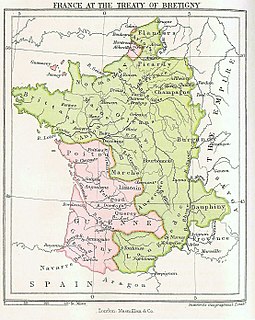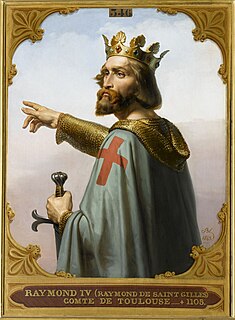Historical background
The 1229 Treaty of Paris put an end to the conflict between the King of France, Louis IX, and the Count of Toulouse, Raymond VII, and provided for the marriage of the latter's daughter, Joan of Toulouse, to King Louis' brother, Alphonse of Poitiers. In the event that they did not have heirs, their estates were to revert to the Crown of France. Among these estates, some, such as Agenais and Quercy, were originally part of the dowry that Joan of England, sister of King Richard I of England, brought when she married count Raymond VI of Toulouse in October 1196.
The 1259 Treaty of Paris signed between King Louis IX and Henry III, King of England, had provided that, in the event that Joan of Toulouse did not have an heir, the estates brought by her grandmother, Joan of England, would return to the English Crown. Henry III had also raised claims to Quercy and Saintonge, but they had not been settled.
In August 1271 Joan of Toulouse and Alphonse of Poitiers died a few days apart, without an heir. As soon as their deaths were known, the King of France, Philip III, declared himself the owner of all their domains, including those which were supposed to go to King Henry III.

Alphonse or Alfonso was the Count of Poitou from 1225 and Count of Toulouse from 1249. As count of Toulouse, he also governed the Marquisate of Provence.

Philip III, called the Bold, was king of France from 1270 until his death in 1285. His father, Louis IX, died in Tunis during the Eighth Crusade. Philip, who was accompanying him, returned to France and was anointed king at Reims in 1271.

Charles IV, called the Fair in France and the Bald in Navarre, was last king of the direct line of the House of Capet, King of France and King of Navarre from 1322 to 1328. Charles was the third son of Philip IV; like his father, he was known as "the fair" or "the handsome".

Guyenne or Guienne ; was an old French province which corresponded roughly to the Roman province of Aquitania Secunda and the archdiocese of Bordeaux.

The Treaty of Brétigny was a treaty, drafted on 8 May 1360 and ratified on 24 October 1360, between King Edward III of England and King John II of France. In retrospect, it is seen as having marked the end of the first phase of the Hundred Years' War (1337–1453) as well as the height of English power on the European continent.

The Duchy of Aquitaine was a historical fiefdom in western, central and southern areas of present-day France to the south of the river Loire, although its extent, as well as its name, fluctuated greatly over the centuries, at times comprising much of what is now southwestern France (Gascony) and central France.

The Count of Toulouse was the ruler of Toulouse during the 8th to 13th centuries. Originating as vassals of the Frankish kings, the hereditary counts ruled the city of Toulouse and its surrounding county from the late 9th century until 1270. The counts and other family members were also at various times counts of Quercy, Rouergue, Albi, and Nîmes, and sometimes margraves of Septimania and Provence. Count Raymond IV founded the Crusader state of Tripoli, and his descendants were also counts there. They reached the zenith of their power during the 11th and 12th centuries, but after the Albigensian Crusade the county fell to the kingdom of France, nominally in 1229 and de facto in 1271.

The Treaty of Paris was a treaty between Louis IX of France and Henry III of England, agreed to on 4 December 1259, ending 100 years of conflicts between the Capetian and Plantagenet dynasties.

Raymond VII was Count of Toulouse, Duke of Narbonne and Marquis of Provence from 1222 until his death.

Agenais, or Agenois, was an ancient region that became a county of France, south of Périgord.

Joan of England was a queen consort of Sicily and countess consort of Toulouse. She was the seventh child of Henry II, King of England, and Eleanor, Duchess of Aquitaine. From her birth, she was destined to make a political and royal marriage. She married William II of Sicily and later Raymond VI, Count of Toulouse, two very important and powerful figures in the political landscape of Medieval Europe.

The Saintonge War was a feudal dynastic conflict that occurred between 1242 and 1243. It opposed Capetian forces supportive of King Louis IX's brother Alphonse, Count of Poitiers and those of Hugh X of Lusignan, Raymond VII of Toulouse and Henry III of England. The latter hoped to regain the Angevin possessions lost during his father's reign. Saintonge is the region around Saintes in the centre-west of France and is the place where most of fighting occurred.

The Battle of Taillebourg, a major medieval battle fought in July 1242, was the decisive engagement of the Saintonge War. It pitted a French Capetian army under the command of King Louis IX and his younger brother Alphonse of Poitiers against forces led by King Henry III of England, his brother Richard of Cornwall and their stepfather Hugh X of Lusignan.

The Treaty of Paris, also known as Treaty of Meaux, was signed on 12 April 1229 between Raymond VII of Toulouse and Louis IX of France in Meaux near Paris. Louis was still a minor, and it was his mother Blanche of Castile, as regent, who was instrumental in forging the treaty. The agreement officially ended the Albigensian Crusade, and according to the terms of the treaty, Raymond's daughter Joan was to be married to Louis' brother Alphonse. Moreover, Raymond ceded the eastern provinces of his lands to Louis and the Marquisat de Provence to the Catholic church. The treaty also gave the Inquisition absolute power regarding searching for, and seizing of, heretics.

Jean I de Grailly was the seneschal of the Duchy of Gascony from 1266 to 1268, of the Kingdom of Jerusalem from about 1272 until about 1276, and of Gascony again from 1278 until 1286 or 1287.

Grilly is a commune in the Ain department in eastern France.
The crown lands, crown estate, royal domain or domaine royal of France were the lands, fiefs and rights directly possessed by the kings of France. While the term eventually came to refer to a territorial unit, the royal domain originally referred to the network of "castles, villages and estates, forests, towns, religious houses and bishoprics, and the rights of justice, tolls and taxes" effectively held by the king or under his domination. In terms of territory, before the reign of Henry IV, the domaine royal did not encompass the entirety of the territory of the kingdom of France and for much of the Middle Ages significant portions of the kingdom were the direct possessions of other feudal lords.

Louis of France was the eldest son of King Louis IX of France and his wife Margaret of Provence. As heir apparent to the throne, he served as regent for a brief period.

The Capetian–Plantagenet rivalry was a series of conflicts and disputes that covered a period of 100 years (1159–1259) during which the House of Capet, rulers of the Kingdom of France, fought the House of Plantagenet, rulers of the Kingdom of England, to suppress the growing power of the Plantagenet-controlled Angevin Empire. Some historians refer to that series of events as the "First Hundred Years War".

The House of Toulouse, sometimes called House of Saint-Gilles or Raimondines, is the name of the dynasty that ruled the County of Toulouse.


















